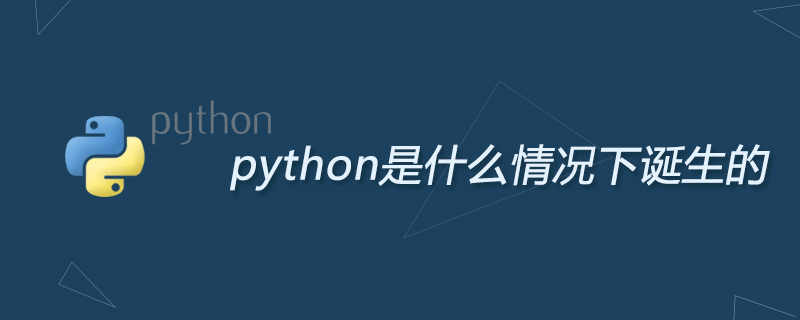Home >Backend Development >Python Tutorial >Under what circumstances was python born?
Under what circumstances was python born?
- (*-*)浩Original
- 2019-06-20 11:20:072775browse
Python is a computer programming language. It is an object-oriented dynamic type language that was originally designed for writing automated scripts (shells). With the continuous updates of the version and the addition of new language features, it is increasingly used for the development of independent and large-scale projects.

In 1989, in order to pass the Christmas vacation, Guido began to write a compiler/interpreter for the Python language. (Recommended learning: Python video tutorial)
Python comes from Guido’s beloved TV series Monty Python’s Flying Circus (an indoor sitcom played by the BBC in the 1960s and 1970s, based on the British atmosphere at that time) life as material). He hopes that this new language called Python can realize his concept (a language between C and shell, full-featured, easy to learn, easy to use, and scalable). As a language design enthusiast, Guido has already made (not very successful) attempts at designing languages. This time, it was nothing more than a pure act of hacking.
In 1991, the first Python compiler (also interpreter) was born. It is implemented in C language and can call C libraries (.so files). Since its birth, Python has had: classes, functions, exception handling, core data types including lists and dictionaries, and module-based Expand the system.
Python syntax comes from C, but it is also strongly influenced by the ABC language. Some rules from the ABC language are still controversial today, such as forced indentation. But these syntax rules make Python easy to read. Python, on the other hand, cleverly chooses to obey some conventions (especially those of the C language). For example, use the equal sign to assign values and use def to define functions. Guido believes that if something is established based on "common sense", there is no need to get too hung up on it.
Python has paid special attention to extensibility (extensibility) from the beginning. Python can be expanded on multiple levels. At a high level, you can import .py files. Under the hood, you can reference C libraries. Python programmers can quickly use Python to write .py files as expansion modules. But when performance is an important factor to consider, Python programmers can go deep into the bottom layer, write C programs, compile them into .so files and introduce them into Python for use. Python is like building a house with steel. First define the large frame. Programmers can expand or change quite freely under this framework.
The original Python was developed entirely by Guido himself. Python is popular among Guido's colleagues. They provide quick feedback and participate in Python improvements. Guido and some colleagues form the core team of Python. They spend most of their free time hacking Python (including work time, since they use Python for work). Subsequently, Python expanded beyond CWI. Python hides many machine-level details and leaves them to the compiler to handle, and highlights logical-level programming thinking. Python programmers can spend more time thinking about the logic of the program rather than the specific implementation details (Guido has a T-shirt that reads: Life is short, I use Python). This feature attracts a large number of programmers. Python became popular.
We have to pause our Python time and take a look at the computer overview at this time. In the early 1990s, personal computers began to enter ordinary households. Intel released the 486 processor, and Windows released a series of window systems starting with window 3.0. Computer performance is greatly improved. Programmers began to pay attention to the ease of use of computers (such as graphical interfaces).
For more Python related technical articles, please visit the Python Tutorial column to learn!
The above is the detailed content of Under what circumstances was python born?. For more information, please follow other related articles on the PHP Chinese website!

